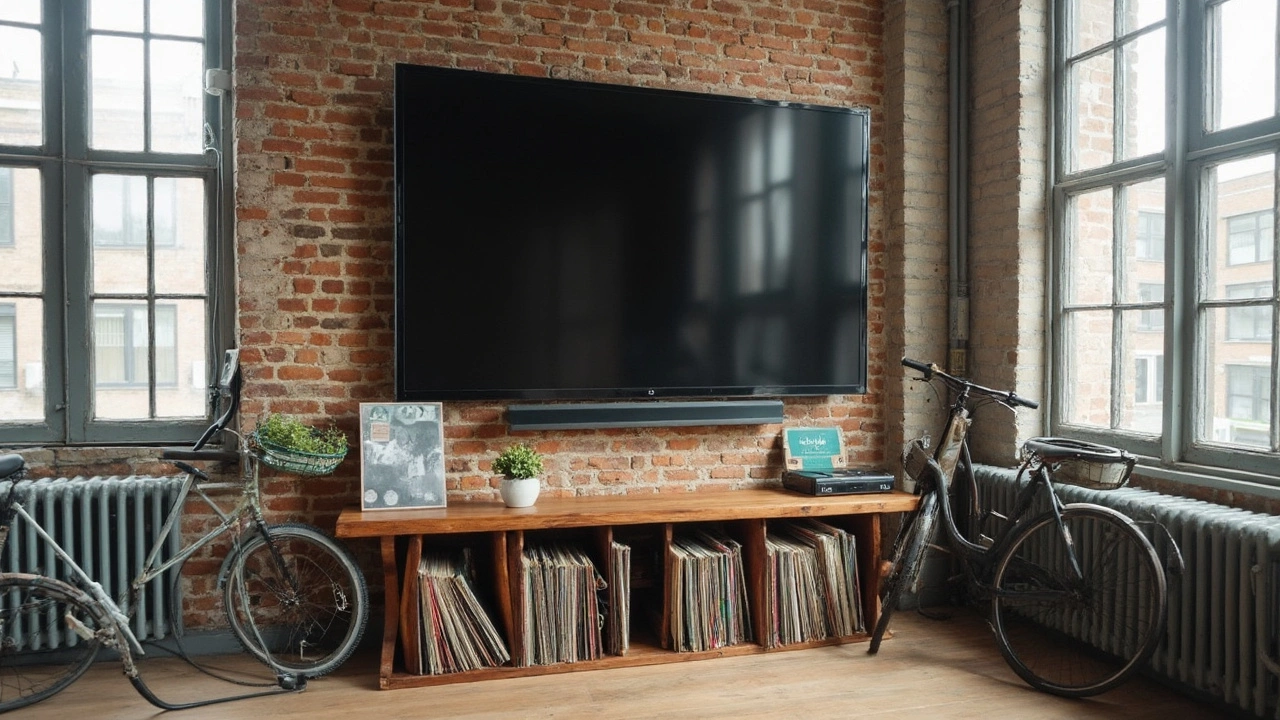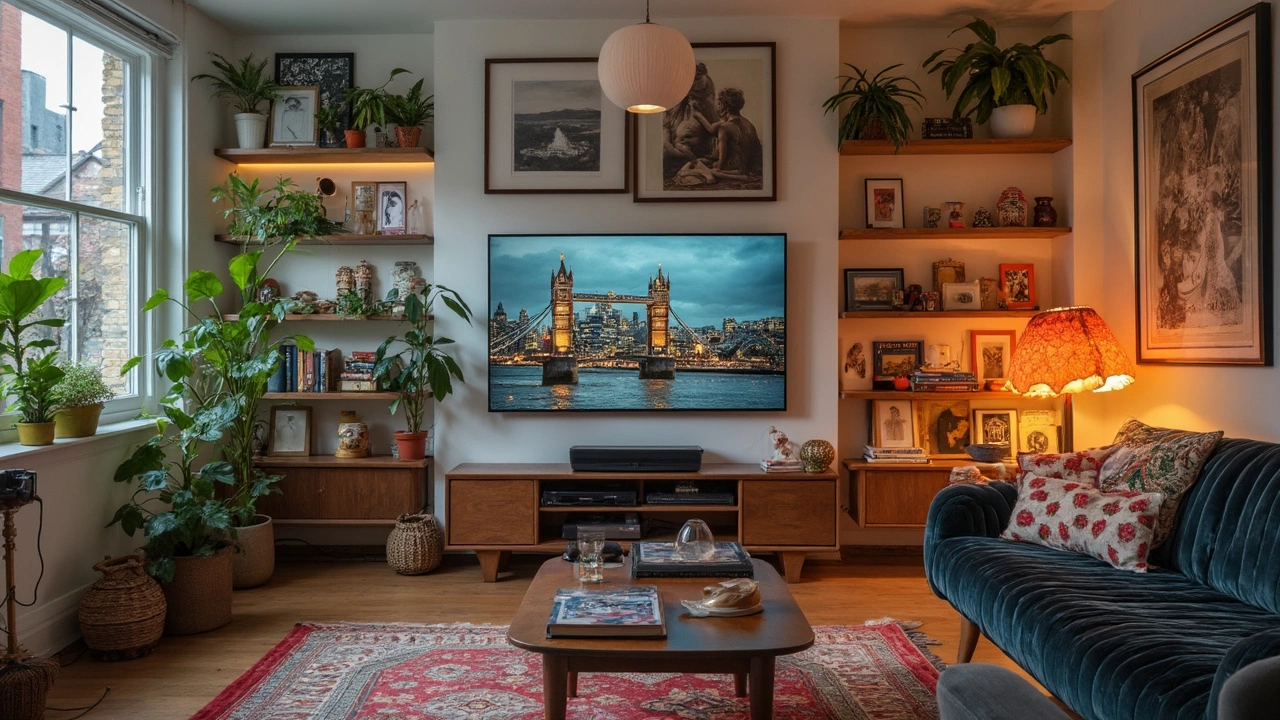You don’t have to stick with the old pressboard TV stand that came with your first apartment. There are so many better options out there, and some of them might already be hiding in your home.
The most obvious swap? Wall mounting your TV. Not only does it clear up valuable floor space, but it also gives your setup a cleaner, more modern look. And if you’re worried about cords cluttering things up, there are affordable cable management kits that literally stick to your wall and keep everything tidy. It’s the fastest way to make your living room feel bigger and less chaotic.
If drilling into your walls isn’t possible, or you just want something different, get creative with furniture you already own. Got an old dresser or bookshelf? That’s fair game for holding a TV. A sturdy console table or even a bench can be a perfect spot. All you need is a flat surface with enough width for your screen and maybe a bit of room to store your remote and a few streaming gadgets. You’d be surprised how many people turn vintage trunks or low credenzas into killer entertainment stations with barely any effort.
- Wall Mounts: A Game Changer
- Repurposed Furniture Tricks
- Storage Solutions That Double Up
- Style and Function: What to Watch For
Wall Mounts: A Game Changer
Mounting your TV on the wall isn’t just for gadget geeks or people showing off on Instagram. It’s honestly one of the most practical moves you can make if you want to dump the old TV stand for good. The big win here? TV stand alternatives like wall mounts save you a ton of space, especially in small living rooms, bedrooms, or even dorms.
Most flat-screen TVs are designed to work with VESA mounts, which just means they have standard holes in the back so you can bolt them safely onto almost any wall mount out there. Full-motion mounts let you pull your TV out from the wall and tilt or swivel it—great if you have windows throwing glare around or want to see the screen from different angles. Fixed mounts are the easiest to install but don’t move; perfect if you always sit in the same spot.
- Mounts typically support TVs from 32" up to 85" or more, but double-check weight limits before you buy.
- You can pick up a basic, sturdy wall mount at big box stores for around $30, while fancier full-motion options can run closer to $100.
- If you rent, look for no-drill or adhesive mounts designed for apartments. They usually work with TVs under 55 lbs.
And what about hiding those ugly wires? Most people can pull off a clean look with a simple cable raceway (those snap-on plastic covers) or by threading wires behind the drywall if you’re handy with a drill.
Want real numbers? Here’s what you can expect with wall mounting vs. a traditional stand:
| Wall Mount | TV Stand | |
|---|---|---|
| Space Needed | Just wall area | 3-5 sq ft (on floor) |
| Average Setup Time | ~45 minutes | ~10 minutes |
| Cost Range | $30–$150 | $50–$300 |
| Cable Visibility | Minimal to none | Visible unless managed |
If you’re nervous about drilling or what’s behind your walls, you can usually find a stud with a $10 stud finder from any hardware store. Some hardware shops even loan out tools for free if you ask. When it’s up, your TV looks like it’s floating—and your space feels bigger instantly.
Repurposed Furniture Tricks
Why buy something new when you can rework what you’ve already got? Turning regular furniture into a TV stand alternative is easier than most people think, and honestly, it’s where you can get the most creative.
Dressers, credenzas, benches, and bookshelves are all up for grabs. Got an old dresser that’s too bulky for your bedroom? Pull out a few drawers for open shelving, or just use the top surface for your TV. The bonus: you get tons of storage for gaming consoles, remotes, and those tangled chords no one wants to see.
Even a basic bookshelf can step in as a solid TV platform, especially for smaller TVs or tight spaces. Try flipping a sturdy bookshelf on its side—the shelves turn into cubbies for streaming boxes, speakers, or even game controllers. Console tables give you that slim modern look and can sometimes squeeze into spots regular TV stands won’t fit, like a hallway or at the end of a bed.
- TV stand alternatives don’t have to be boring or standard—antique trunks, low coffee tables, and old filing cabinets work in a pinch if they’re sturdy.
- If you’re a fan of DIY, look for thrift-store finds and give them a coat of paint or swap out knobs to match your room’s style.
- Don’t ignore stability: TVs get heavier with size, so check the label on furniture for weight limits before you stack.
- Add non-slip pads under your TV or anchor your makeshift stand to the wall if you’ve got kids or pets zooming around.
Here’s a quick comparison to help you pick what works for your space:
| Furniture Type | Average Weight Limit (lbs) | Best For |
|---|---|---|
| Dresser | 100-200 | Large TVs with storage needs |
| Bookshelf | 40-60 (top shelf) | Small to midsize TVs in tight rooms |
| Console Table | 50-100 | Modern look, narrow spots |
| Trunk/Credenza | 80-150 | Statement piece, extra storage |
Sometimes the best setup is the one you mash together yourself. If you want your space to actually feel like you—not some home decor showroom—don’t be afraid to experiment with what you’ve got.

Storage Solutions That Double Up
If your living room has more gadgets and game controllers than you do places to put them, you’re not alone. This is where a smart storage solution can do double duty—keeping things tidy while holding your TV securely. The trick is to find something that not only looks good but actually works for your lifestyle.
Media consoles, especially with deep drawers or shelving, make a lot of sense here. Ikea’s BESTÅ system is popular for a reason: you can customize it to fit any size TV and stash everything from router boxes to vinyl records out of sight. Add doors if you want to hide clutter, or keep things open for easy access. Many people use baskets or bins on open shelves to corral remotes, chargers, and gaming headsets.
Cubes or cubby units are surprisingly effective, especially in small spaces. Set a TV on top, load the cubbies with storage cubes or boxes, and suddenly you’ve got room for board games, DVDs, or even sneakers if you’re working with a studio apartment. Plus, it’s easy to swap out bins for a fresh look.
If you want to get even more creative, try a storage bench. These usually come padded, so you get bonus seating, and the inside gives you a neat spot for extra blankets or your console controllers. They can make a living area look way more pulled together, especially if you choose a bench the same length as your TV or longer.
One quick tip: always make sure your furniture is sturdy enough for the size and weight of your TV. Some particleboard units will flex over time. If you own a larger screen, go for solid wood or metal frames instead. Your TV stand alternatives shouldn’t put your gear at risk—no one wants to scramble to catch a falling TV!
Style and Function: What to Watch For
Finding the right TV stand alternatives isn’t just about saving space or reusing furniture. You want your room to look good and still work for your everyday life. Nothing ruins a movie night like an uncomfortable setup or a cable mess that can trip you up.
First, make sure the spot you pick won’t put your neck at a weird angle. Your TV should sit about eye level when you’re on the couch. This helps cut down on neck and back strain, and you’ll actually enjoy watching it.
Think about storage, too. If you’ve got game consoles, speakers, or streaming devices, look for a solution with shelves or easy spots to stash stuff. Some folks use simple storage bins or baskets to hide clutter on open shelves, which keeps everything tidy but easy to grab.
Material matters more than you’d think. Glass surfaces look sleek, but smudge up fast and need lots of cleaning. Wood or metal is generally tougher and works best for homes with kids or pets running around.
- Cable management is huge. Don’t ignore it. Cord covers and clips are cheap but make all the difference, especially if your setup is right in the middle of the living room.
- Match the look with your style. Matte black metal stands blend into modern rooms, while mid-century or rustic pieces add some warmth. No need to buy all new furniture – a fresh coat of paint or some new hardware can totally change the vibe of something you already own.
- Stability is key. TVs can be top-heavy. Make sure your furniture is sturdy and won’t tip over easily. Anti-tip straps for furniture aren’t just for kids’ rooms – they’re cheap and can save you plenty of headaches.
People often forget about lighting, but it actually matters. If you have a window right behind your TV, it can cause glare and make watching frustrating. Try to set up your TV so it avoids direct sunlight, or use thick curtains if you can.
So in the end, pay attention to comfort, safety, and the look that fits your space. A little planning at the start makes every show or game feel way better in the long run.


Write a comment